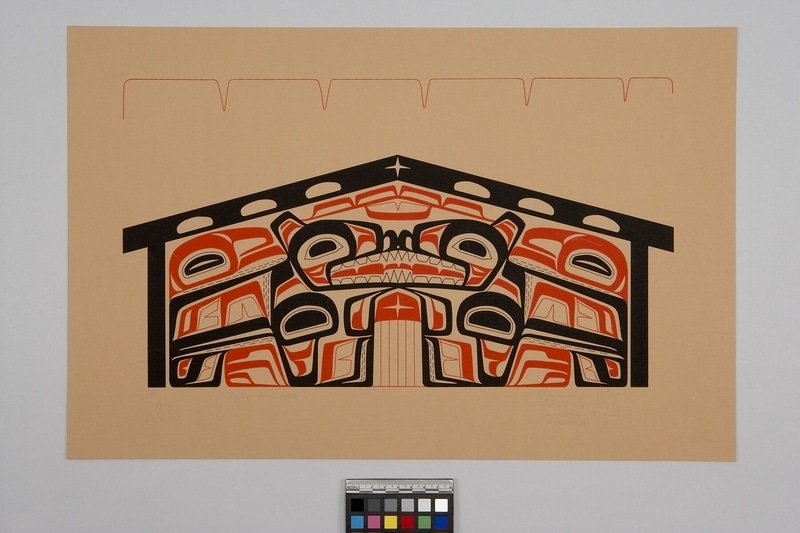House of Wolves Item Number: Nb7.289 from the MOA: University of British Columbia

Description
Stylized image of a house front. Gabled roof and outside supports in red-orange bands. House front design is bilaterally symmetrical. Door at the centre bottom has six vertical red lines and a cross shaped star in a domed section above. Matching star at top of the gable. Large profile face in black line above and to sides of door. Has a short snout; open mouth, even teeth rows with triangular canines, and a red segmented tongue between. Ovoid eyes and a red split u on the cheek. Other major elements include a large ovoid to the sides at the top with black concentric ovoids at the centre. Series of red u forms, split u's, and s-shape below in a rectangular black section. Black and red u forms and split u sections across the bottom. Black ovoid below the head at either side. Series of evenly spaced ovoids along the gables. Steeply notched red horizontal line across the top of the print above the house. Pencil inscription across the bottom edge reads '19/80 6/10/76 HOUSE OF WOLVES Roy Henry Vickers TSIMSHIAN TRIBE KITKATLA B.C.HEBREWS 11:10'. The print on a horizontally rectangular, brown paper stock.
History Of Use
Northwest Coast serigraphs are a contemporary art form, deriving from early 20th century drawings of traditional crest and decorative designs, commissioned by anthropologists and undertaken by artists such as Charles Edenshaw. Residential schools reinforced the medium, while discouraging the use of traditional themes. An important series of traditional designs in coloured pencil and watercolour were done by Mungo Martin for UBC in 1949-50. The 1960's saw the rapid growth of prints, first in unlimited poster editions, and later with the establishment of the Gitanmaax School of Northwest Coast Indian Art at 'Ksan (1967), and of the Northwest Coast Indian Artists Guild (1977), limited edition art runs became the standard. Northwest Coast silkscreen prints are part of the mainstream art market, as well as functioning within the native context as potlatch gifts, and commemorative prints. Although there are distinctive regional styles, individual artists may work in several styles, or apply unique themes and variations to specific works.
Cultural Context
contemporary art
Iconographic Meaning
Hebrews 11:10 for he looked for a city which hath foundations whose builder and maker is god.
Item History
- Made by Roy Henry Vickers (Maker) in British Columbia, Canada during October 1976
- Owned by Norman Sandomirsky and Tobie Sandomirsky before June 27, 1984
- Received from Norman Sandomirsky (Donor) and Tobie Sandomirsky (Donor) on June 27, 1984
What
- Name
- House of Wolves
- Identification Number
- Nb7.289
- Type of Item
- Manufacturing Technique
- silkscreened
- Overall
- height 33.0 cm, width 50.8 cm, depth 0.1 cm
Who
- Culture
- Tsimshian
- Creator
- Roy Henry Vickers (Maker)
- Previous Owner
- Norman Sandomirsky and Tobie Sandomirsky
- Received from
- Norman Sandomirsky (Donor) and Tobie Sandomirsky (Donor)
Where
- Holding Institution
- MOA: University of British Columbia
- Made in
- British Columbia, Canada
When
- Creation Date
- during October 1976
- Ownership Date
- before June 27, 1984
- Acquisition Date
- on June 27, 1984
Other
- Item Classes
- works on paper
- Condition
- good
- Accession Number
- 0979/0003